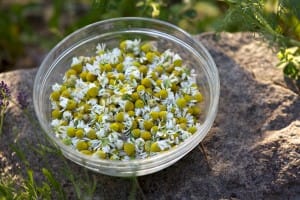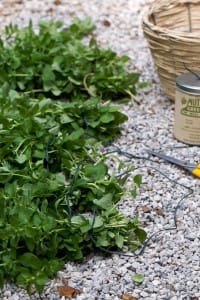Source(s): Wayne McLaurin, Professor Emeritus of Horticulture, The University of Georgia, College of Agricultural and Environmental Sciences
Herbs grown for foliage may be harvested at any time, though the essential oils are most concentrated just prior to blooming. The seedheads of herbs grown for their seeds, such as fennel and dill, may be collected soon after seeds have reached maturity. Herbs are best collected in the late morning, rinsed quickly, and air dried. Drying or freezing will preserve them.
Drying
The ideal conditions for drying herbs is a warm, dry, dark, well-ventilated place. An attic or similar room with good air circulation meets all these conditions. The simplest method is to tie herb stems together in small bunches and hang the bunches upside down from a rod or rafter. The bunches should not touch so that air can freely circulate around them. Herbs to be dried for seed collection can be enclosed in large paper bags with holes cut into the sides for air circulation.
It is difficult to recognize dried herb leaves, so label the bunches.
Herbs may be dried in a gas oven at very low temperature, about 100 degrees F (electric ovens cannot usually be set at this temperature). Strip the leaves from the stems and place them in a single layer on a wide, flat sheet or pan. With the door of the oven ajar, the herbs should dry sufficiently in about three to five hours. Stir herbs gently every 30 minutes during the drying period.
Herbs can be dried in a microwave oven. The preferred method is to put the herb leaves in between paper towels. Microwave about one minute on low. If herbs are not dry, microwave several more seconds. Herbs will burn quickly in a microwave and volatile oils may spark. Sparking, like browning of the leaves, indicates overprocessing. Herbs dried in the microwave should retain a green color.
Store herbs away from heat out of direct light. If moisture forms on the inside of the storage container, redry the herbs.
Freezing
Herbs are prepared for freezing by a quick rinsing, then by shaking off the excess moisture and patting the leaves dry. Remove the leaves from the stems, put in labeled freezer bags, and store in the freezer. An alternate method is to drop the leaves into ice trays, fill with water, and freeze. The quality of frozen herbs will usually begin to deteriorate after about three to six months. Strong-flavored herbs, such as chives and rosemary, may affect other foods in the freezer and should be stored in freezer jars.
Special Uses of Herbs
Herbs have been grown for centuries for artistic, culinary, and medicinal uses. There is a great resurgence of interest in herbal treatments for human illness. Many traditional uses have not been sufficiently documented, however, and scientists have not identified nearly all of the compounds present in various parts of herb plants. They do not know for certain the effect on the individual of medicinal herbs, either in single use or use in combination. It is important to know the margins of safety in using herbs. Use caution with unfamiliar herbs.
A growing body of literature exists about herbs and herb uses. Explore herbal medication and cosmetic use carefully through reputable sources. There is a growing body of literature on herbs and herb uses, including cosmetic and medicinal.
Herbs can be enjoyed many ways; dried in bundles, used in flower arrangements, or made into potpourris, they add to interior decor and scent the air. Herbs are also incorporated with other garden materials into wreaths, “tussie-mussies,” bath accouterments, herbal pillows and hot pads, as well as cosmetic products.
Potpourris
While a successful moist potpourri is somewhat difficult to concoct, a dry potpourri can be made from almost any combination of herbs, dried flowers and spices as long as some basic rules are observed. The plant parts must be thoroughly dry and a fixative should be used for longevity. The mixture should be made, stored, and used in a non-metallic container; it should season for six to eight weeks.
Fixatives absorb and release the essential oils in herbs that otherwise would evaporate and be lost. The most common fixatives are orris root (or calamus), gum benzoin, and vetiver. Add prepared essential oils to the fixative and then combine into the mixture. The oils can also be used later to restore scent to potpourris.
A Basic “Recipe” for Potpourri
1 quart dried herb leaves, e.g., lemon verbena, scented geranium)
1 quart dried flowers or flower parts (e.g., rose, marigold)
1 ounce fixative
5-10 drops essential oil
Mix in a non-metallic container; cover tightly; store in a dark, cool place; allow to season about two months. Stir or shake the mixture periodically. Put the mixture in a decorative container that can be covered when not being used to preserve the scent.
Resource(s): Herbs in Southern Gardens
Center Publication Number: 261
- Growing Herbs - September 24, 2013
- Harvesting and Preserving Herbs - September 24, 2013
- Herbs in the Landscape - September 24, 2013
